Saag (Punjabi Greens)
Print this recipeMy saag recipe is the traditional method, with lots of short cuts, not turning the occasion of making saag into a time consuming and stressful event.
I would always help my mum to wash and chop the green leaves, but once it went into a pan, I never understood the thickening or cooking process, it took too long and I had so little patience that I had to teach this to myself. I have had to learn to cook this dish myself so feel free to learn from the many mistakes I have made. We had a family taste test a few years ago, I am proud to say, my saag can stand its’ own against my mum’s (her signature dish).
My mum and many other Indian mums have an OCD with washing the leaves, their method is something like this: the leaves are checked, any brown or outer leaves are discarded, thick stems removed, first they are soaked in warm water, then drained, chopped and washed again before starting to cook, probable four times per leaf!
When boiling the leaves, you will see that I boil them until they are mushy, not for hours as my mum would. I’ve also created many short cuts, it will all make sense when you follow my recipe and instructions, please have a go.
There is no usual spicing involved, no dried masalas or turmeric, this is an altogether different style of cooking, truly unique to Punjabis – just ginger, garlic, chillies and salt. It was the only time we added fresh ginger and garlic to dishes, so necessary to add flavour.
Saag has a creamy consistency, my mum would beat the leaves with her wooden spoon, we would all have to help with giving the pan a good stir, I don’t ‘phone a friend, ask the audience, I simply use my hand blender, remember my taste test before you judge.
Restaurant-style dishes with the word saag, isn’t what we would call saag, that to home cooks is actually palak (just spinach). Saag is considered a healthy dish, I am not convinced as it’s boiled and simmer, it’s tasty and great for a detox and perfect comfort food at this time of year.
I use fresh ingredients, all my leaves, ginger, garlic, chillies are fresh and you may use frozen if that works for you, my mum always added a tin of saag, she felt it added colour, I don’t bother, adding fresh spinach towards the end of cooking is good enough.
I prefer coarse cornmeal flour to thicken the saag and to make the chappatties so I just buy one flour, rather mixing the two, as my mum would use fine and coarse cornmeal flour for the breads.
When choosing leaves, I like to add fresh methi leaves aka fresh fenugreek leaves, or use dried ones, just check them for big stalks and rinse before adding towards the end of cooking time. I have used sprouts, savoy cabbage, chard, so I have tried and tested a good mixture of greens and they always work.
For the greens in this recipe, they are simply a guideline, you need fresh green leaves so if you can’t get curly kale or spring cabbage, please use any green leafy veg you can get.
Please read my instructions carefully before you start, have the ingredients ready and you can have a huge pan of saag made from start to finish within an hour and a half, not two days, like my mum.
Regarding butter, I always use a dairy free version and it’s fine as long as it’s seasoned with chillies and salt, the lack of usual butter is not obvious.
The recipe given starts with a big pan of washed and chopped fresh or frozen greens.
This recipe makes 5 tubs, we eat one and save the four tubs of 500g in our deep freeze for a speedy, but healthy meal.
Ingredients
Instructions
Work out which leaves will take longest to cook, if they have thick stems, they will take the longest so start with them.
I always wash the bags of leaves, even if they are ready washed, I give them a quick rinse.
Start by chopping the ends off and any rough leaves, give them a quick chop. I keep the stems and just give the edges a trim.
Put a big cooking bowl in the sink, fill with warm water and soak your leaves for a few minutes, now lift the leaves and put into a colander, any grit should remain in the bowl and rinse the leaves in a colander.
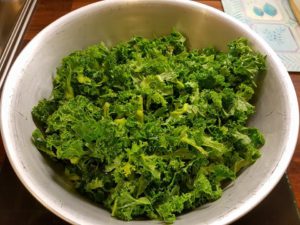
Place the leaves in the big pan and pour in just enough water to cover the leaves, bring to boil whilst you start cleaning, chopping and washing the next set of leaves.
Pop any stalks you have into the pan to start cooking first, they are nutritious, please do not discard them.
The leaves will be added to the pan as you wash, don't add any extra water and keep stirring, mashing the leaves to get them cooked as quickly as possible.
It takes me twenty minutes to get the leaves all washed, roughly chopped and in the pan.
Whilst the leaves are bubbling away, peel and (roughly) chop ginger, peel your garlic cloves, along with your chillies (stems removed) give them a quick rinse and place them in you food processor, give them a whizz to make a smooth crush.
Set the processor aside with the crushed ginger, garlic and chillies in it.
Meanwhile, fry your onion in the small pan, using the rapeseed oil, just keep an eye on them and when they are golden, add the onions to the food processor and give it all a good whizz until you have a puree.
Place the onion mix into a pan and continue to fry until the mix is golden and the ginger/garlic is cooked, keep this mix on a low heat to prevent burning.
The leaves should be suitably cooked and need to be thickened at this point, there should be some liquid left in the pan, just about a couple of mug fulls, if not, add a little.
Take the cup of cornmeal flour and place in a big jug and pour in enough water to make a gloopy mix, and stir together well, ensure there aren't any lumps.
Now, add the gloopy mix to the leaves and give a good mix, don't let the pan boil and simmer for 15 minutes, whilst you keep stirring the pan, it should be a creamy mash like constituency.
We are simply cooking the cornmeal mix out and thickening the leaves at the same time.
Check you can use your stick hand blender in the pan and blend all your leaves until they are smooth, a little texture is ok.
Now add the onion mix, salt and butter to the big pan and simmer for a further ten minutes, don't forget to give the pan a good stir.
The longer you allow to simmer, the nicer it tastes and I sometimes put it in my slow cooker to finish.
Be careful, it will stick so needs a lot of stirring. I allow it to simmer whilst I make the breads.
Enjoy with traditional chappatties or be adventurous and try making your cornmeal chappatties (makki di roti)
Here is the recipe for the cornmeal flatbreads:
https://www.lajinamasala.com/recipe/makki-di-roti-cornmeal-or-polenta-flatbreads/
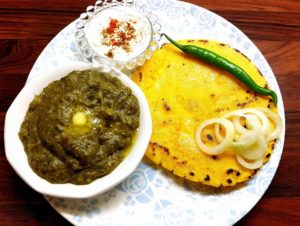
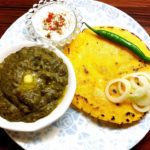

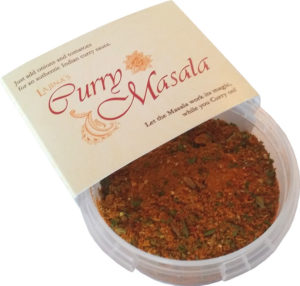
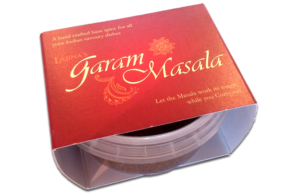

Reviews
There are no reviews yet.